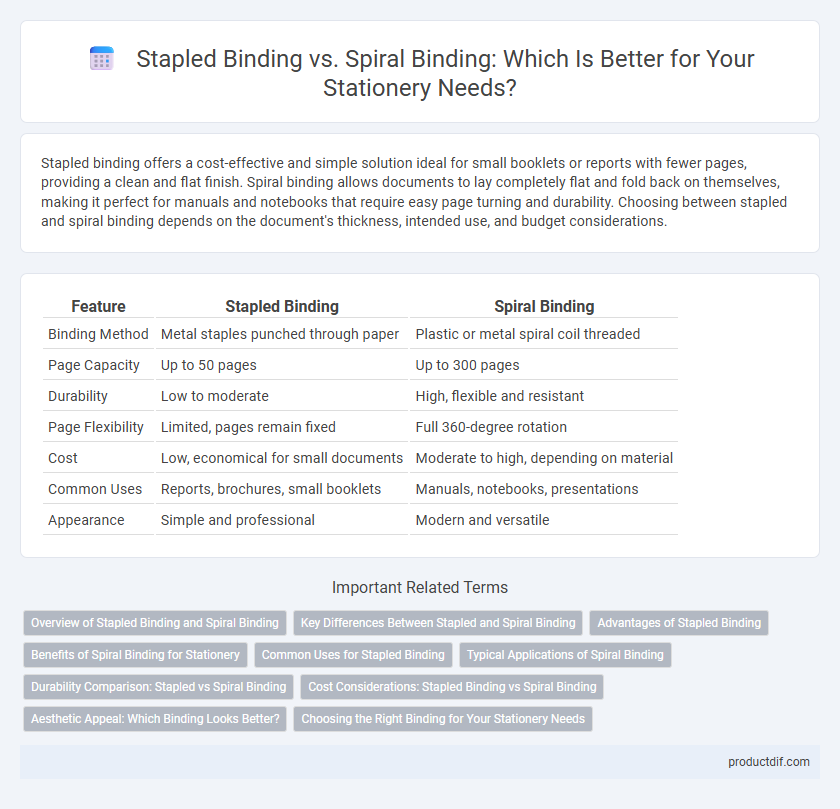Stapled binding offers a cost-effective and simple solution ideal for small booklets or reports with fewer pages, providing a clean and flat finish. Spiral binding allows documents to lay completely flat and fold back on themselves, making it perfect for manuals and notebooks that require easy page turning and durability. Choosing between stapled and spiral binding depends on the document's thickness, intended use, and budget considerations.
Table of Comparison
| Feature | Stapled Binding | Spiral Binding |
|---|---|---|
| Binding Method | Metal staples punched through paper | Plastic or metal spiral coil threaded |
| Page Capacity | Up to 50 pages | Up to 300 pages |
| Durability | Low to moderate | High, flexible and resistant |
| Page Flexibility | Limited, pages remain fixed | Full 360-degree rotation |
| Cost | Low, economical for small documents | Moderate to high, depending on material |
| Common Uses | Reports, brochures, small booklets | Manuals, notebooks, presentations |
| Appearance | Simple and professional | Modern and versatile |
Overview of Stapled Binding and Spiral Binding
Stapled binding, also known as saddle stitching, uses metal staples to secure folded sheets along the spine, making it ideal for booklets and short documents with up to 80 pages. Spiral binding employs a continuous plastic or metal coil threaded through punched holes, allowing books to lay flat and pages to turn 360 degrees, commonly used for manuals and notebooks. Both methods offer durability and ease of use, with stapled binding favoring compactness and spiral binding emphasizing flexibility and page accessibility.
Key Differences Between Stapled and Spiral Binding
Stapled binding secures pages with metal staples, offering a cost-effective and simple solution for small documents, while spiral binding uses a plastic or metal coil threaded through punched holes, allowing the book to lay flat and rotate 360 degrees. Stapled binding is ideal for brochures or booklets with fewer pages, whereas spiral binding accommodates thicker documents and provides durability and flexibility for frequent use. The choice between stapled and spiral binding depends on document thickness, usage frequency, and presentation needs.
Advantages of Stapled Binding
Stapled binding offers a cost-effective and quick solution for small booklets and reports, making it ideal for short-term or limited-use documents. It ensures pages remain securely fastened and aligned, providing a neat and professional appearance suitable for presentations and handouts. This method allows for easy customization with various staple sizes and orientations, enhancing versatility in stationery projects.
Benefits of Spiral Binding for Stationery
Spiral binding offers enhanced durability and flexibility for stationery documents, allowing pages to lie flat and easily turn without damage. It supports higher page counts compared to stapled binding, making it ideal for thicker notebooks, manuals, and reports. The plastic or metal coils used in spiral binding also provide a professional appearance and customizable options in color and size.
Common Uses for Stapled Binding
Stapled binding is commonly used for documents with fewer pages, such as brochures, reports, booklets, and flyers, where quick assembly and low cost are priorities. This binding method is ideal for office memos, instructional manuals, and school assignments that require a simple, secure hold. Stapled binding supports easy page flipping and is preferred for temporary or frequently updated materials.
Typical Applications of Spiral Binding
Spiral binding is commonly used for notebooks, manuals, and reports that require durability and frequent page turning. Its flexible design allows documents to lay flat or fold back on themselves, making it ideal for instructional materials and workbooks. This binding method is preferred in educational and professional settings where ease of access and frequent reference to pages is essential.
Durability Comparison: Stapled vs Spiral Binding
Stapled binding offers a cost-effective solution for short-term use, but its durability is limited due to the staples' tendency to rust or loosen over time. Spiral binding provides superior durability with its flexible plastic or metal coil that resists wear and allows pages to turn smoothly without tearing. For documents expected to undergo frequent handling or long-term storage, spiral binding is the more reliable option.
Cost Considerations: Stapled Binding vs Spiral Binding
Stapled binding is generally more cost-effective for small booklets or documents with fewer pages, as it requires minimal materials and simple equipment. Spiral binding tends to be more expensive due to the cost of plastic or metal coils and the need for specialized machinery, making it better suited for thicker documents or presentations. Businesses should evaluate the page count and frequency of use to determine the most economical binding option.
Aesthetic Appeal: Which Binding Looks Better?
Stapled binding offers a clean and minimalistic aesthetic, ideal for slim booklets and documents, providing a sleek and professional appearance. Spiral binding enhances visual appeal with its exposed coil, available in various colors and materials, giving a modern and customizable look. Choosing between stapled and spiral binding depends on the desired style, document thickness, and overall presentation goals.
Choosing the Right Binding for Your Stationery Needs
Stapled binding is ideal for small booklets and promotional materials due to its cost-effectiveness and simplicity, while spiral binding offers durability and flexibility, making it perfect for notebooks and manuals that require frequent page turning. Consider the document's thickness and intended use; stapled binding suits thin publications up to 64 pages, whereas spiral binding accommodates thicker volumes with easy page access. Selecting the right binding enhances usability, presentation quality, and overall customer satisfaction in your stationery products.
Stapled Binding vs Spiral Binding Infographic

 productdif.com
productdif.com